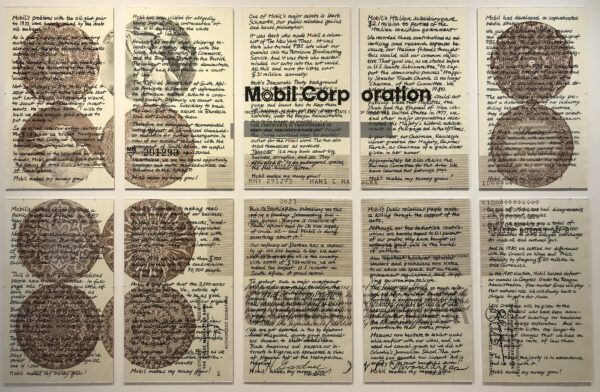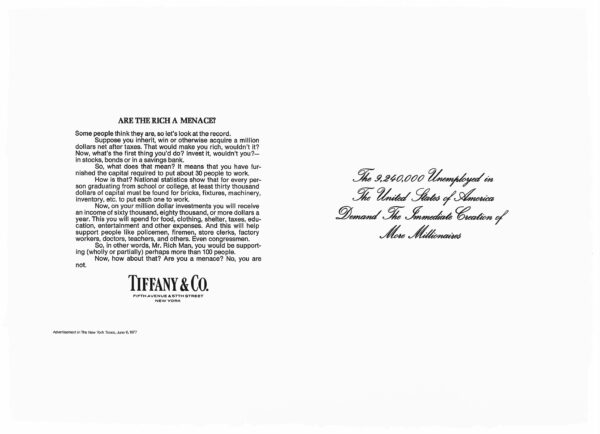Hans Haacke was born in Cologne, Germany in 1936 and has lived in New York City since 1965. Through painting, installation, and photography, Haacke focuses on political and social systems, particularly those related to the art-world. His work often breaks down boundaries and challenges the relationships between art institutions and the corporations that support those institutions. He has been both celebrated and censored for his controversial art. In a 2010 Artforum interview, he explained “It is uncomfortable for me to be a politicized artist…. the work of an artist with such a label is in danger of being understood one-dimensionally without exception…. all artwork has a political component whether it’s intended or not.”
During World War II, bombs fell around Hans Haacke’s family’s neighborhood in Cologne. His father, who was affiliated with the Social Democratic party, lost his job with the City of Cologne after refusing to join the Nazis. The family subsequently moved to a small town in the southern district of Bad Godesberg for safety. Haacke studied at the State Art Academy in Kassel, graduating with a degree in art education in 1960. As a student, he participated in the second edition of Documenta, a large art exhibition that takes place every five years in Kassel as a way to bring Germany up to speed with modern art after the years of Nazi censorship. From 1961 to 1962, he studied at the Tyler School of Art at Temple University in Philadelphia on a Fulbright scholarship and often took bus trips to New York to see exhibitions and connect with other artists.
While living in Germany, Hans Haacke became affiliated with Zero, an international group of artists dedicated to anti-subjective art production. The group emphasized the removal of traditional art mediums, instead calling for use of everyday material or “ready-mades”. After he moved to New York City in 1965, Haacke started targeting the economic relationships between corporations and the art market. He credits Ludwig von Bertalanffy’s book General System Theory as an inspiration for his transition to institutional critique: “[it] gave me a deeper understanding and inspired me to continue with my kinetic, process-oriented works, and also to expand into biological and—toward the late 1960s—to deal with social systems.”
Hans Haacke’s art became increasingly political during the ‘70s, perhaps influenced by the nation-wide frustration due to the ineffectiveness of the Vietnam War, as well as unrest surrounding the civil rights movement following Martin Luther King’s assassination. His art was a creative outlet to protest unfair systems and expose them to the public’s attention. One of his first political works was a poll box at the Museum of Modern Art that queried visitors, “Would the fact that Governor Rockefeller has not denounced President Nixon’s Indochina Policy
be a reason for your not voting for him in November?” (1970). In his historical landmark art work, Shapolsky et al. Manhattan Real Estate Holdings, A Real Time Social System, as of May 1, 1971, Haacke exposed the questionable transactions of New York’s biggest slum landlord, Harry Shapolsky, and his real-estate business between 1951 and 1971. For his proposed 1971 solo show at the Guggenheim Museum, Haacke planned to mount an index of the museum’s corporate sponsors and board of trustees to the walls of the museum. The controversial show was cancelled six weeks before opening, and its curator Edward Fry was fired. Haacke spent the following decade showing his work in Europe, where it was widely accepted.
Haacke worked in the Crown Point Press studio in 1978 and 1982. His first project, Tiffany Cares, is a photoetching of two texts side by side. The left is a direct copy of an advertisement Tiffany & Co. put in the New York Times in 1977 titled “Are the Rich a Menace?” The ad contained a statement by Walter Hoving, chairman of the company, which laid out the theory of “trickle-down” economics in support of tax cuts for the rich and exploitation of the poor. To the right of the Tiffany text is a response by Haacke in script font declaring, “The 9,240,000 Unemployed in The United States of America Demand The Immediate Creation of More Millionaires.” His sarcastic message calls out Tiffany during a time when the United States was emerging from a recession.
In 1993, Haacke represented Germany at the Venice Biennale and his work, Germania, won the top prize. His work examined Germany’s past and Adolph Hitler’s visit to the 1934 Venice Biennale. Recalling the piece, he said “I decided to represent Germany in both senses of the term: being the official representative of Germany– the flag bearer, so to speak– and producing a representation of the country. Preparing for this task, I researched the pavilion’s history, and, for hours, sat alone in its nave which had been assigned to me.”
Hans Haacke and his wife, Linda, have two sons. He refused to rely on the sales of his art to support his family; instead, a majority of his income came from teaching at Cooper Union from 1967 to 2002. He rejects the idea of idolizing artists and refuses to be photographed, explaining “I have something against the fetishism of the artist that is associated with the face and celebrity.” He has been using a contract since the early ‘70s that gives him a percentage of any resale profit and power to determine where his work will be exhibited. His works are held in the collections of the Art Institute of Chicago; The Museum of Modern Art in New York; the Los Angeles County Museum of Art; and the Tate Gallery in London, among others. He lives and works in New York.
-Carleigh Koger
BOOKS ABOUT THE ARTIST

